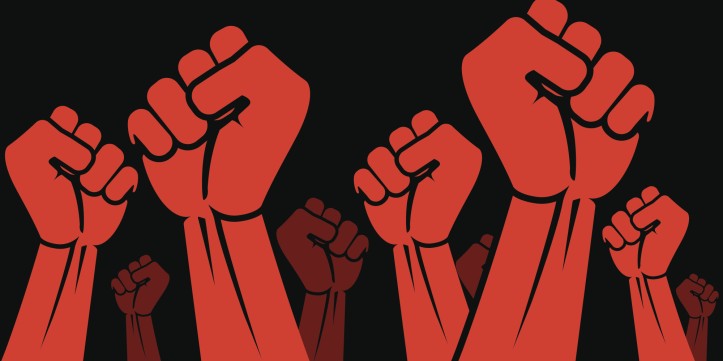From Radical Education Department
The resurgence of Antifa has placed the problem of fascism front and center for radical politics today. It also raises a key strategic question: if we are to disrupt, dismantle, and transform fascism–to ensure “no platform for fascists”–what is it that makes the Trump regime fascist, and what are its sources and mechanisms? Discussions on the left surrounding these issues have often been limited. They tend to focus on governmental or state fascism, endlessly comparing and contrasting past fascist governments and the current, American one. In doing so they miss a broader socio-political fascism: the Trump regime is one expression of a diffuse fascistic desire for violent domination as well as of the fascistic social structures in which that desire is generated and cultivated.
The task of Antifa must be to challenge not only narrower, governmental fascism but also its broader social roots. This project entails standing in radical, active solidarity with struggles against white supremacy, misogyny, anti-worker class warfare, transphobia, xenophobia, and beyond, as one node in a broad-based, radical left struggle. In this post, we sketch the need for such a popular-front Antifa.
Some Limits to How We Are Talking about Fascism
Discussions about the term “fascism” raging on the left since the Trump campaign have often been deeply limiting. They tend to be obsessed with a fairly narrow understanding of fascism as a phenomenon of state, which they explore by comparing and contrasting 21st century America and 20th century fascist governments. Such analysis certainly has value, particularly in raising the alarm, but leaves us with a seemingly endless debate. Many argue that we can and should unequivocally call the administration fascist given its white supremacist and nationalist policies, cultivation of white supremacist violence, demonization of immigrants, attacks on the media, and so on. But as others point out, certain hallmarks of past fascist states are missing, like a wholesale attack on individualism. Others chart a middle path: “No, but …” Across the debate we find a dizzying array of new terms: Trump is a “proto-fascist,” “neo-fascist,” or maybe an “ur-fascist.”
This endless battle misses history. It presents “fascism” as though it were a fixed set of characteristics, failing to ask: how might fascism, like a virus, become “resistant,” taking on new forms and strategies that allow it to survive in changed contexts? Moreover, when we assume that fascism is solely a function of who is in charge of a country’s political machinery, we come to see Antifa, in turn, as a highly specialized struggle, implicitly rejecting any deep connection between Antifa and the vast array of other social struggles with which it might create a mass radical project. We thereby also ignore the much wider, fascistic base on which Trump builds. To combat the limits of this discussion, we must shift our gaze.
Fascistic Desire and a Popular-Front Antifa
Beyond the left’s endless debates, we should recognize that the Trump regime’s ambiguous state fascism embodies a much broader desire to violently dominate humans and nature that is diffused throughout American society. State fascists cannot rise to power without mobilizing and constantly reproducing this desire, but the latter can and does assume both explicit and implicit forms, within and outside the machinery of state. The desire for domination is generated in structures that have always organized life in American society: imperialism; militarization; local and state police; misogyny; the construction of masculinity as authoritarian violence; white supremacy; American nationalism’s constant refrains of exceptionalism; and many more. The capitalist order, inherently authoritarian, provides the framework in which all these develop: it seeks to capture every part of society and every moment of life for a brutal competition in which a few heroes will rise to rule over the unwashed masses.

Such structures organize the violent domination and eradication of human and non-human life, constituting socio-political fascism. When we call them, and the desire for domination that they nurture, “fascistic,” we point out that they make state fascism possible. At the same time, the term highlights the fact that state fascism is a symptom of a much broader problem that must not be reduced to an issue of who runs the government. A fascist state is the reflex of an obscene social order trying to defend itself against the threat posed by a dominated populace.
From this shifted perspective, we do not need to endlessly debate just how fully Trump fits into a fixed definition of fascism derived from the past. Instead, if we recognize the Trump regime as emerging out of the convergence of particular fascistic tendencies at a given time and in a given place, we can see that its ambiguously fascist form is tailored to the American context and sensibilities, accommodating itself, for instance, to American individualism by forgoing appeals to mass unity. Whether Trump is a “proper” fascist–whether he fits into a rigid definition taken from the past–matters much less than that he is opposed as the governmental voice of a pervasive fascistic violence.
Nor do we have to see Antifa as a specialized, narrow struggle against a particular regime. Antifa can see its work as inseparable from all those that struggle against fascistic desire in the diverse, irreducible forms that make an obscenity like Trump possible: against white supremacy, misogyny, transphobia, anti-worker class warfare, and beyond.
Pursuing its task–”no platform for fascists”–Antifa would then attack socio-political fascism in all its many forms. It would stand in radical solidarity with, and constantly learn from, a vast array of left social struggles–and so aim to be one part of an intersectional, popular-front Antifa.